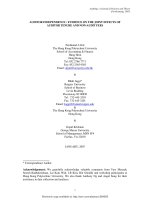Identifying and non identifying relative clauses
Bạn đang xem bản rút gọn của tài liệu. Xem và tải ngay bản đầy đủ của tài liệu tại đây (9.95 KB, 1 trang )
Identifying and non-identifying relative clauses
The relative pronoun that can refer to both people and things. In other words, it can replace both who and which.
However, this is not always possible. That cannot be used in non-identifying relative clauses. Note that a
non-identifying relative clause can be easily removed from the sentence. An identifying relative clause, on the
other hand, cannot be removed that easily. If it is removed from the sentence, the meaning will change.
They opposed the motion that / which was proposed by the rival group.
Now remove the relative clause ‘that / which was proposed by the rival group’ and you will get the simple
sentence ‘They opposed the motion’.
As you can see, this sentence does not mean the same as the original sentence because it doesn’t identify the
motion under discussion.
Now consider another sentence.
My sister, who lives in New York, is a classical dancer. (NOT My sister, that lives in New York,…)
Here the relative clause who lives in New York is non-identifying. It merely provides additional information. Even if
you remove it from the sentence the meaning doesn’t change.
My sister is a classical dancer.
As you can see, this sentence means the same as the original sentence; it just doesn’t give as much information.
In writing, non-identifying relative clauses are separated by commas.
Exercise
State whether the relative clauses in the following sentences are identifying or non-identifying and rewrite them
using appropriate punctuation marks.
1. I have got a book which is really interesting to read.
2. I met a girl who sells flowers.
3. Maya who sells flowers in the street is a pretty girl.
4. This is Jane who works with my sister.
Answers
1. Identifying (No commas are required.)
2. Identifying (No commas are required)
3. Non-identifying (Maya, who sells flowers in the street, is a pretty girl.)
3. Non-identifying (This is Jane, who works with my sister.)
Stay on top of your writing! Download our grammar guide from www.englishgrammar.org to stay up-to-date.
Powered by TCPDF (www.tcpdf.org)









